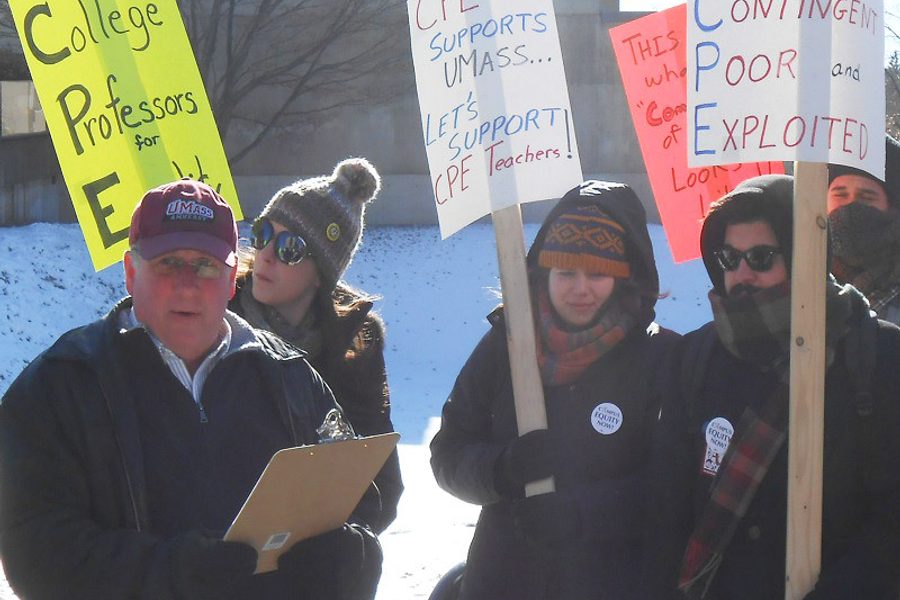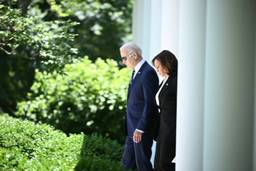
Amidst of a wave of recent campaigns to organize contingent faculty at universities around the country, about 50 people braved single-digit temperatures on Friday outside the University of Massachusetts Amherst administration building to rally in support of a group of adjuncts seeking union representation.
Instructors with the university’s Continuing and Professional Education (CPE) unit — a parallel campus unit offering both online and in-person courses to traditional and nontraditional students — are aiming for “accretion,” a legal maneuver that would allow them to join the faculty union on campus and be covered under the same contract.
The effort is being spearheaded by the Massachusetts Society of Professors (MSP), a Massachusetts Teachers Association-affiliated union that represents about 1,400 faculty members and librarians at UMass Amherst, including the majority of the university’s nearly 500 adjunct (non-tenure-track) professors. But many CPE instructors are currently excluded, with tangible effects: While the unionized adjunct instructors make a minimum of $6,400 per course and receive health benefits, non-union instructors at CPE make a minimum of only $3,200 per course and get no benefits.
According to UMass Amherst’s website, CPE is designed to offer university courses on a more flexible schedule to adults and working professionals, in addition to students designing their own majors. And instructors who have taught both through CPE and directly through the university say that though the pay and benefits are different, the work is not. “I teach the exact same classes online through CPE that I teach on campus,” says an instructor, who asked not to be identified for fear of retaliation. “It’s the same classes, the same work effort, the same intellectual property, oftentimes the same set of students, administered by the same department, getting credit in the same degree, with funds coming back to the same university — and yet all that work is not on the same union membership.”
Though some of CPE’s classes are taught in person, most are taught online. Professors point out, however, that online instruction is by no means easier. Elizabeth Sharpe, who has taught a history course online through CPE since last year, stresses that teaching online requires the same amount of personal attention for students as a traditional on-campus class, if not more. “I get to know the students very well because they have to produce so much. It’s very time consuming for the professor to be there all the time,” she says. “I’ll spend the better part of the day reading [essays] and replying to each student, because you’ve got to write everything out [as opposed to speaking with students in person]. It’s a very personal approach.”
In addition to the $3,200 per course minimum, non-union CPE teachers are paid according to a step rate based on the number of students enrolled in each class. MSP organizers argue this system is similar to piece work, in which workers are paid based on the units they produce — a pay scheme more typical of overseas garment factories than U.S. professional sectors. “Right now, I have 11 students. But if I had 12, I’d be paid [about] a thousand dollars more,” Sharpe says. “It’s very arbitrary.”
The MSP says the number of CPE classes — about 225 out of a total 3,000 offered by the university — has grown “tremendously” in recent years. There are now required, credit-bearing courses for some on-campus majors offered exclusively through CPE, which the union says represents the “outsourcing” of university instruction to lower-paid workers.
And because they’re part of a separate campus unit, these classes usually include additional service and curriculum fees beyond those already charged to full-time students. This, says MSP President Randall Phillis, “generates considerable income for the university, but adds to the debt burden of students taking these courses.”
“This is the Walmartization of the university,” Phillis adds. “The administration has set up a two-tier system where some courses are delivered as standard parts of the curriculum, but are done so by instructors paid only half-price.”
According to the MSP, there are currently 229 CPE instructors. Ninety-six of them also currently teach traditional courses on campus and are therefore part of the MSP bargaining unit, while another 34 are graduate students and members of the Graduate Employee Organization (GEO), part of UAW Local 2322. But the 99 instructors who teach directly and exclusively for CPE lack any representation whatsoever.
Earlier this month, the MSP approached the UMass administration to formally request that these 99 non-union CPE instructors be allowed into the unit. The administration refused, telling the union they did not agree that the instructors share a “community of interest” with unionized faculty — the litmus test for forming a single bargaining unit.
“I don’t really understand that logic,” says Sharpe, who previously taught a traditional course on campus. “I’m the same person, I’ve taught both, and my community of interest hasn’t changed.”
Even more puzzling, the union says, is that at the university’s sister campus, UMass Boston, Continuing Education instructors are already eligible to be part of the same bargaining unit as the rest of the faculty. Considering the similarities between that program and CPE, this discrepancy in policy “makes no sense to us at all,” says MSP organizer Ferd Wulkan.
In an email, UMass spokesperson Ed Blaguszewski tells Working In These Times that “further information [on why the university does not recognize a shared community of interest] will be shared as part of the state process to review the accretion petition.”
In response to the university’s refusal, the MSP organized last Friday’s rally. Both union and non-union faculty, as well as graduate-student union members and representatives of Western Mass Jobs with Justice, gathered to deliver the message, as MSP organizer Brian Pickett put it: “Here we are as a community of interest and here we are as an interested community.”
Though many non-union CPE instructors were on-hand, most preferred to remain anonymous, fearing reprisal from the university. After all, as contingent faculty, they must be reappointed every semester, and the administration can choose not to invite them back. This is what happened last year to Ellen Martins, president of UMass Lowell’s recently formed adjunct union, who had taught at the university for 28 years before suddenly being told she would not be reappointed. (After allegations of illegal retaliation and a statewide campaign on Martins’ behalf, UMass Lowell reinstated her in September.)
Western Mass Jobs with Justice Coordinator Jon Weissman, who organizes with Walmart associates and other low-wage workers, says the CPE instructors’ preference for anonymity is “representative of the culture of fear regarding union organizing in America … [Workplace organizing] is the last civil right being exercised in an atmosphere of terror.” Asked to comment on these fears of retaliation, Blaguszewski says the university “respect[s] the right of faculty and instructors to voice their views freely.”
Immediately after the rally, MSP organizers formally filed an accretion petition with the Massachusetts Department of Labor Relations, which has the power to bring the non-union instructors into the existing bargaining unit. They expect it could take the DLR weeks — or even months — to carry out an investigation and issue a ruling. In the meantime, the MSP plans to continue organizing CPE teachers and will prepare to bargain a new contract later this year, which union leaders hope will include greater equity and security for adjuncts already in the unit.
Jeff Schuhrke is a labor historian and assistant professor at the Harry Van Arsdale Jr. School of Labor Studies, SUNY Empire State University. He is the author of Blue-Collar Empire: The Untold Story of US Labor’s Global Anticommunist Crusade.







